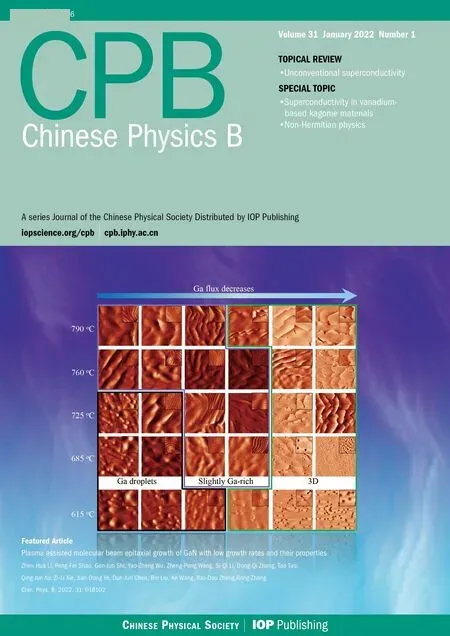Demonstration of Faraday anomalous dispersion optical filter with reflection configuration
Yi Liu(刘艺) Baodong Yang(杨保东) Junmin Wang(王军民) Wenyi Huang(黄文艺)Zhiyu Gou(缑芝玉) and Haitao Zhou(周海涛)
1College of Physics and Electronic Engineering,Shanxi University,Taiyuan 030006,China
2State Key Laboratory of Quantum Optics and Quantum Optics Devices and Institute of Opto-Electronics,Shanxi University,Taiyuan 030006,China
3Collaborative Innovation Center of Extreme Optics,Shanxi University,Taiyuan 030006,China
Keywords: Faraday effect,optical filter,remote sensing
1. Introduction
Faraday anomalous dispersion optical filter (FADOF)based on the atomic transitions in a vapor cell is usually used to remove the background noise from weak signal light,or used as frequency-selecting element for the strong signal light at the level of~mW.[1-4]In comparison with the usual interference filter,FADOF has many advantages such as narrow bandwidth, excellent background rejection, and high transmittance,[5-7]so it has been widely applied to the optical communication,[8,9]underwater optical communication,[10,11]laser lidar remote sensing system,[12,13]Faraday laser,[14]laser frequency stabilization,[15]optical clocks,[16]etc. Since FADOF was demonstrated in 1956,[17]it has been studied theoretically and experimentally.[18-20]At present,many Faraday filters have been realized based on the transitions between the ground state and the excited state in the experiments.[21-23]They have high transmittance because the atoms are usually populated on the ground state, but the selectable working wavelength is restricted by a limited number of transition lines from ground state. For having more choices of working wavelengths, the excited state Faraday anomalous dispersion optical filter (ES-FADOF) becomes the focus of research,[24-26]but it is still a challenge for the realization of high transmittance, because the ES-FADOF requires that the atoms can be effectively populated to the intermediate excited state from the ground state.[27-30]
Up to now, the conventional FADOF uses the transmission configuration in the experiments,[18-22]in which the signal light passes through the vapor cell just once. In this work, based on the cesium 6S1/2-6P3/2transition at 852 nm,a reflection-type FADOF is demonstrated with higher transmittance in comparison with the transmission configuration FADOF under the same experimental parameters,because the reflecting FADOF allows the signal light to pass through the Cs vapor cell twice. This reflection-type FADOF can be extended to the ES-FADOF for the higher transmittance.
2. Principle and experimental setup
The relevant hyperfine energy levels of Cs atom are shown in Fig.1. The frequency interval between the two hyperfine energy levelsF=3 and 4 in the ground state 6S1/2is 9192.6 MHz, and the frequency intervals between the four hyperfine energy levelsF′= 2, 3, 4, and 5 in the excited state 6P3/2are 151.2 MHz, 201.3 MHz, and 251.1 MHz,respectively. A home-made 852 nm external cavity grating feedback diode laser with a mode-hop-free tuning range of~6000 MHz, serves as the signal light, and its frequency is tuned to the 6S1/2F=4-6P3/2transition line. The spot diameter of the signal laser beam is~1.6 mm.
The experimental setup of traditional FADOF with transmission configuration is shown in Fig.2(a):it is composed of a pair of Glan-Taylor prisms(G-T1,G-T2)set with orthogonal polarization directions, a pair of annular permanent magnets(H1, H2) generating axial magnetic field, and a temperaturecontrolled cesium vapor cell (Cs cell). The transmittance of FADOF is calculated regardless of the system optical loss,such as from the absorption and reflection of two windows of Cs vapor cell,G-T prisms,etc. The transmittance of FADOF in Fig.2(a)is recorded as the ratio of light power transmitted when the G-T1 is perpendicular to G-T2 under Faraday rotation with the magnetic field on to that when G-T1 is parallel to G-T2 with the magnetic field off in Fig.2(a),excluding the atomic absorption.[11,21]
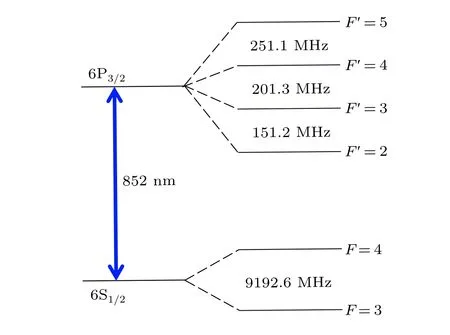
Fig.1. Relevant Cs energy levels.
According to the Faraday magneto-optic rotation effect,the rotation angle of polarization plane of linearly polarized signal light is determined byθ=VBL,whereVis the Verdet coefficient,Bis the magnetic field strength andLis the length of the medium.It can be seen that the longerLis,the larger the angleθis,and the more obvious the Faraday rotation effect is.More importantly, the rotation direction of polarization plane of linearly polarized signal light is only related to the direction of magnetic field,and has nothing to do with the propagation direction of signal light in the Faraday effect.So in our design,the reflecting FADOF is shown in Fig. 2(b): the polarization beam splitter cube (PBS) is used to generate linearly polarized signal light. The signal light goes and returns through a temperature-controlled Cs cell by a 0°highly reflecting mirror (M), and then the rotated signal light is reflected by the PBS into the photodiode detector (PD). In order to improve the extinction ratio of the reflection-type FADOF system,another G-T prism with extinction ratio of~105:1 is inserted in front of the PD.The length of Cs cell is~5.0 cm,the diameter is~2.5 cm,and there is no buffer gas. Different from the traditional FADOF, the magnetic field designed in this work adopts a number of Nd2Fe14B N38 permanent magnets (the diameter of~12 mm and length of~10 mm),which are magnetized along the thickness direction, to form some magnetic columns with lengths of~11 cm. These magnetic columns are fixed symmetrically and regularly around the Cs vapor cell along the axial direction. The generated axial magnetic field(B=7-870 G)can be adjusted by increasing or decreasing the number of magnetic columns, and its inhomogeneity in the Cs cell’s region is less than 5%. The greater intensity of axial magnetic field is, the better its uniformity is, which meets the requirements of FADOF experiment. Similar to the definition of transmittance for the transmission-type FADOF regardless of the system optical loss, the transmittance of reflecting FADOF is defined as the ratio of signal light power transmitted when the G-T prism is perpendicular to the polarization direction of input signal light from the PBS with magnetic field on to that when they are parallel by rotating the quarter wave plate(QWP)in Fig.2(b)with magnetic field off,excluding the atomic absorption.[11,21]
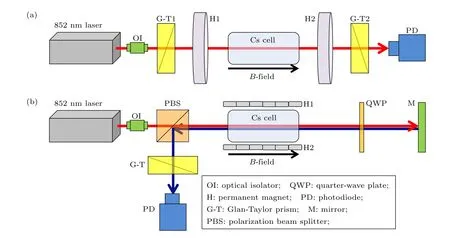
Fig.2. Experimental setup of Cs FADOF with transmission-configuration(a)and FADOF with reflection-configuration(b).
3. Experimental results and discussion
When the power of incident 852 nm signal light on the FADOF is 125 µW, the axial magnetic fieldBis 19 G, the temperature of Cs cell isT=30°C, 40°C, 50°C, and 60°C,and the transmitted spectra are shown in Fig. 3(a) for the transmission-type FADOF and in Fig. 3(b) for the reflectiontype FADOF,respectively. The upper line is the saturated absorption spectrum(SAS)of Cs 6S1/2F=4-6P3/2transition,which is used as a frequency ruler to calibrate the horizontal axis of FADOF spectra in experiment, and the location of 0 frequency detuning is corresponding to the Cs 6S1/2F=4-6P3/2F′= 5 transition. As can be seen from Fig. 3, the FADOF spectra all exhibit obvious wings modes in the two experimental configurations.[22]

Fig.3. Typical transmitted spectra of the FADOF at different Cs cell temperatures(T =30, 40, 50, 60 °C)with transmission configuration(a)and with reflection configuration(b)at the static axial magnetic field of 19 G.The upper line is the saturated absorption spectrum(SAS)of Cs 6P1/2 F=4-6P3/2 F′=3,4,5 transitions as a frequency reference.
3.1. Influence of temperature on the performance of FADOF
The changes of transmittance and linewidth of FADOF spectra with the temperature of Cs cell are shown in Fig.4 for the transmission and reflection configurations,and the relevant experimental parameters are the same as those in Fig.3. With the increase of the temperature of Cs cell,the number of atoms involved in the Faraday anomalous dispersion increases, and the magnetic rotation effect is also enhanced, thus the transmittance of optical filter increases for the two types of FADOFs as shown in Fig.4(a). Furthermore,figure 4(a)shows that the transmittance of reflecting FADOF is significantly higher than that of transmission-type FADOF at the same temperature,because the signal light in the reflecting FADOF can pass through the Cs vapor cell more than once,and more atoms are involved in Faraday effect. When the temperatureT ≤55°C,the transmittance of reflection configuration filter is approximately twice of that of the transmission configuration filter,perhaps because for the former,the effective length of the Cs vapor cell is twice of that of the latter;atT>70°C,the transmittance of the two kinds of FADOFs reaches saturation, the transmittance for reflecting FADOF is as high as~90%,and that for transmission configuration FADOF is about~74%.From another viewpoint, in the case of the same transmittance of optical filter, the required temperature of Cs vapor cell in reflecting FADOF is obviously lower than that in the transmission-type FADOF. This point is beneficial to the realization of FADOF based on the atom with a high melting point.
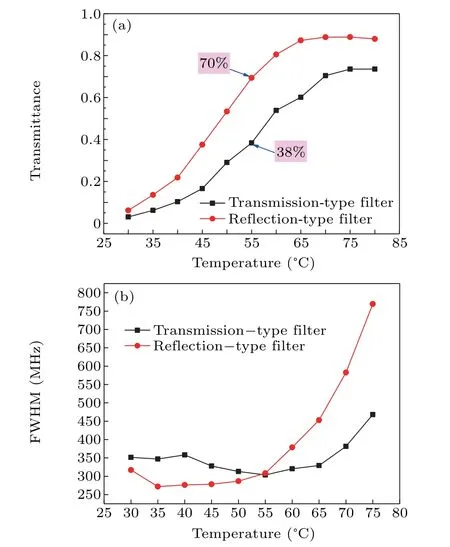
Fig. 4. Comparisons of peak transmittance (a) and linewidth (b) vary with temperature of Cs cell between transmission-type and reflection-type FADOFs;continuous curves are guides to the eye.
The evolution of FADOF spectral linewidth with the temperature of cell for the transmission and reflection configurations is shown in Fig.4(b). At the temperature ofT=30°C,the spectral transmittance is low and the linewidth is relatively wide for the two configurations: the spectral FWHM of transmission filter is 351 MHz,while that of reflection filter is 317 MHz. As the temperature increases, the transmittance of the spectral lines increases rapidly as shown in Fig. 4(a),and the linewidth shows a downward trend: whenT=35-55°C, the FWHM of transmission filter fluctuates between 304 MHz and 360 MHz, while that of reflection filter varies between 270 MHz and 308 MHz. Therefore, the linewidth of reflection filter is slightly narrower than that of transmission filter in this temperature range. When the temperatureTis above 55°C, although the linewidth of reflection filter is larger than that of transmission filter, its maximum linewidth is less than~1 GHz,which still belongs to narrow bandwidth atomic filter.[14,22]
3.2. Effect of magnetic field on the performance of reflecting FADOF
In addition to the influence of temperature on the performance of FADOF,we have further measured the influence of magnetic field on the performance of reflecting FADOF. The related experimental parameters are as follows: the temperature of Cs cell isT=40°C, and the power of signal light is 125µW.The typical spectral lines of reflection-type FADOF are obtained by changing the intensity of axial magnetic fieldB=7-194 G,as shown in Fig.5.
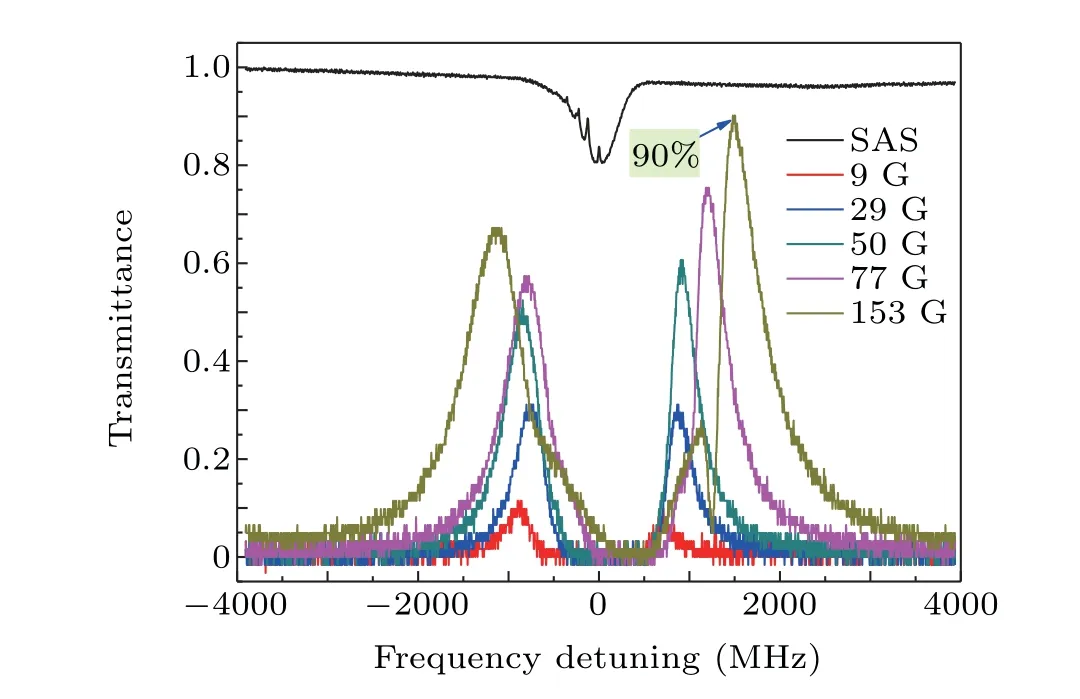
Fig.5.Transmitted spectra of the reflecting FADOF in the different magnetic field(B=9,29,50,77,153 G)at the Cs cell temperature of 40 °C.
With the increase of magnetic field intensity, the Zeeman splitting distance of atomic energy level increases, and the magnetic rotation effect is enhanced, so the transmission of FADOF also increases as shown in Fig.6. AtB=20-60 G,the transmittance increases rapidly from 18% to 68%, whenB=60-100 G, the transmittance increases slowly from 68%to 85%,and when the magnetic fieldB>100 G,the transmittance tends to saturation,about 90%.The linewidth of FADOF spectra increases linearly from 210 MHz to 464 MHz with the increase of magnetic fieldB=7-194 G, as shown in Fig. 6.With the further increase of magnetic field,the FADOF spectrum will turn into a complex multi-peak structure, the peak transmittance will start to go down, and the equivalent noise bandwidth will also increase, which will not be discussed in detail here. Making a comparison, at about room temperatureT=40°C andB=45 G,the transmittance of the reflecting FADOF is up to 61% as indicated in Fig. 6, while that of the transmission-type FADOF is only 31%. Experimental data once again show that the reflecting filter does have certain advantages in improving the transmittance compared with the traditional transmission-type filter,and also has characteristics of narrow linewidth as shown in Fig.6.
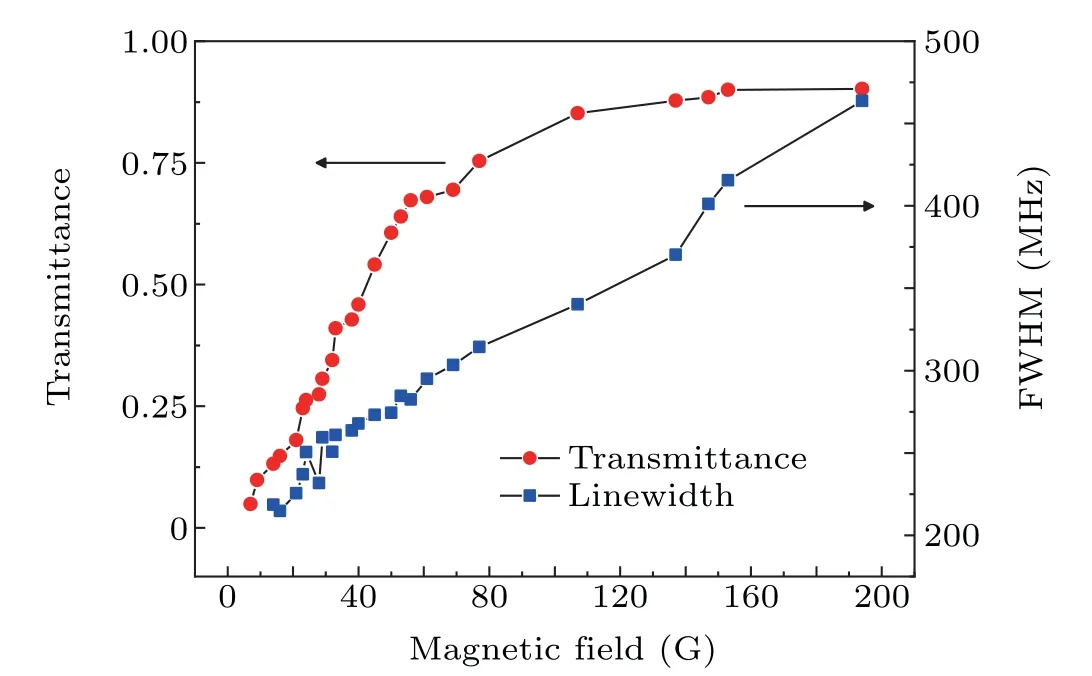
Fig. 6. Peak transmittance and linewidth vary with magnetic field intensity for reflecting FADOF;continuous curves are guides to the eye.
4. Conclusion and outlook
We have developed a reflecting FADOF based on the Cs 6S1/2-6P3/2transition at 852 nm in experiment. The results show that the peak transmittance of FADOF is effectively improved by the reflection configuration compared with the traditional transmission configuration, and its linewidth of the spectral line is in the same order of magnitude as that of the transmission-type filter, which all belong to the narrow linewidth optical filters. This technique experimentally reveals that the rotation direction of linearly polarized signal light is determined by the direction of applied magnetic field in FADOF, and paves the way for the realization of FADOF in which the signal light passes through the atomic vapor cell multiple times for the optimal length of vapor cell. It can be applied to the FADOF based on the atom with high melting point and ES-FADOF for the higher transmittance, and will further expand the application value of FADOF.
Acknowledgments
Project supported by the National Natural Science Foundation of China (Grant Nos. 61975102 and 11974226), the National Key Research and Development Program of China(Grant No. 2017YFA0304502), the Scientific and Technological Innovation Programs of Higher Education Institutions in Shanxi, China (Grant No. 2019L0101), and the Natural Science Foundation of Shanxi Province, China (Grant No.20210302123437).
- Chinese Physics B的其它文章
- Superconductivity in octagraphene
- Soliton molecules and asymmetric solitons of the extended Lax equation via velocity resonance
- Theoretical study of(e,2e)triple differential cross sections of pyrimidine and tetrahydrofurfuryl alcohol molecules using multi-center distorted-wave method
- Protection of entanglement between two V-atoms in a multi-cavity coupling system
- Semi-quantum private comparison protocol of size relation with d-dimensional GHZ states
- Probing the magnetization switching with in-plane magnetic anisotropy through field-modified magnetoresistance measurement

